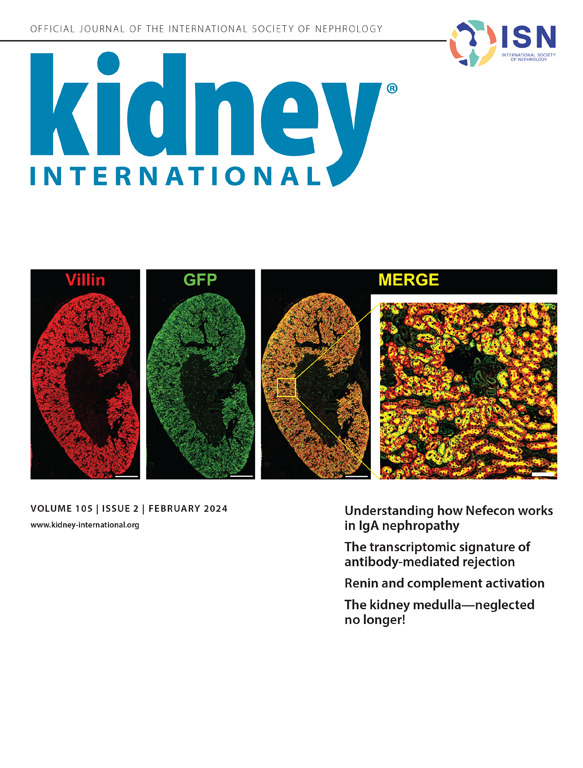Analysis of the prespecified FIDELITY pooled patient dataset examined the efficacy and safety of finerenone in patients with an acute change in estimated glomerular filtration rate.
IF 14.8
1区 医学
Q1 UROLOGY & NEPHROLOGY
引用次数: 0
Abstract
INTRODUCTION The efficacy and safety of finerenone (a non-steroidal mineralocorticoid receptor antagonist) versus placebo were assessed according to different changes in estimated glomerular filtration rate (eGFR) using data from FIDELITY, a pooled individual-level analysis of two clinical trials. METHODS Patients had chronic kidney disease (eGFR of 25 ml/min/1.73m2 or greater) and type 2 diabetes with optimized renin-angiotensin system blockade. Risk of composite cardiovascular and composite kidney outcomes was analyzed by baseline eGFR change at month one in the total population and by treatment group. RESULTS Of 12,798 patients, 25.1% had a >10% eGFR decline, 31.2% had a >0-10% decline, 26.8% had a 0-10% increase, and 16.8% had a >10% increase after one month of treatment. Factors associated with acute eGFR decline included higher baseline urine albumin-to-creatinine ratio, eGFR, systolic blood pressure, diuretic or beta-blocker use, and finerenone use. Finerenone significantly reduced composite cardiovascular and kidney outcomes overall and had similar beneficial effect across eGFR subgroups of >10% decline, >0-10% decline, 0-10% increase, and >10% increase for composite cardiovascular (hazard ratio [95% Confidence Interval] of 0.74 [0.61-0.90], 0.87 [0.73-1.04], 1.06 [0.87-1.28], and 0.78 [0.61-0.99], respectively) and kidney outcomes (0.67 [0.53-0.85], 0.78 [0.61-1.01], 0.56 [0.40-0.77], and 0.75 [0.50- 1.14], respectively) (P interaction 0.048 and 0.23, respectively). When modeled as a continuous variable, finerenone reduced the risk of cardiovascular and kidney outcomes, irrespective of acute eGFR change (P interaction 0.58 and 0.36 respectively). CONCLUSION The cardiovascular and kidney benefits of finerenone were not modified by an acute eGFR change after drug initiation.对预先指定的FIDELITY合并患者数据集的分析检查了芬烯酮对肾小球滤过率估计急性改变的患者的有效性和安全性。
根据估算肾小球滤过率(eGFR)的不同变化,使用来自FIDELITY的数据(两项临床试验的汇总个人水平分析)来评估finerenone(一种非甾体矿物皮质激素受体拮抗剂)与安慰剂的疗效和安全性。方法慢性肾病患者(eGFR大于等于25 ml/min/1.73m2)和2型糖尿病患者采用优化的肾素-血管紧张素系统阻断治疗。综合心血管和综合肾脏结局的风险通过第一个月时总体人群和治疗组的基线eGFR变化进行分析。结果在12798例患者中,治疗1个月后,25.1%的患者eGFR下降> ~ 10%,31.2%的患者> ~ 10%下降,26.8%的患者> ~ 10%升高,16.8%的患者> ~ 10%升高。与急性eGFR下降相关的因素包括基线尿白蛋白与肌酐比、eGFR、收缩压、利尿剂或受体阻滞剂的使用以及细烯酮的使用。Finerenone总体上显著降低了心血管和肾脏的复合结局,并且在eGFR亚组中,>下降10%、>0-10%下降、>0-10%升高和>10%升高具有相似的有益效果(风险比[95%可信区间]分别为0.74[0.61-0.90]、0.87[0.73-1.04]、1.06[0.87-1.28]和0.78[0.61-0.99])和肾脏结局(0.67[0.53-0.85]、0.78[0.61-1.01]、0.56[0.40-0.77]和0.75[0.50- 1.14])。P互作分别为0.048和0.23)。当建模为连续变量时,细芬烯酮降低了心血管和肾脏结局的风险,与急性eGFR变化无关(相互作用P分别为0.58和0.36)。结论芬尼酮对心血管和肾脏的益处不因用药后急性eGFR变化而改变。
本文章由计算机程序翻译,如有差异,请以英文原文为准。
求助全文
约1分钟内获得全文
求助全文
来源期刊

Kidney international
医学-泌尿学与肾脏学
CiteScore
23.30
自引率
3.10%
发文量
490
审稿时长
3-6 weeks
期刊介绍:
Kidney International (KI), the official journal of the International Society of Nephrology, is led by Dr. Pierre Ronco (Paris, France) and stands as one of nephrology's most cited and esteemed publications worldwide.
KI provides exceptional benefits for both readers and authors, featuring highly cited original articles, focused reviews, cutting-edge imaging techniques, and lively discussions on controversial topics.
The journal is dedicated to kidney research, serving researchers, clinical investigators, and practicing nephrologists.
 求助内容:
求助内容: 应助结果提醒方式:
应助结果提醒方式:


